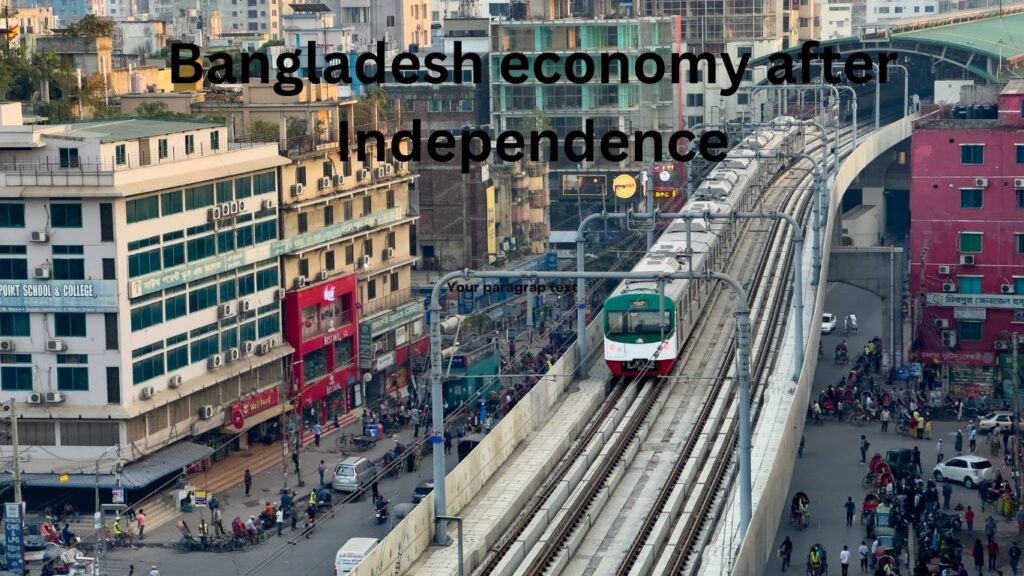Bangladesh, a nation that emerged as an independent country on December 16, 1971, has undergone a remarkable economic transformation. From being labeled a “basket case” by then U.S. Secretary of State Henry Kissinger to becoming one of the fastest-growing economies in the world, Bangladesh’s journey is a testament to resilience, strategic planning, and the determination of its people. This article explores the key phases of Bangladesh economy after Independence evolution over the past five decades.
1.The Initial Struggles: 1971-1980s
The birth of Bangladesh was marked by devastation. The Liberation War in 1971 left the country’s infrastructure in ruins, and it inherited a fragile Bangladesh economy after Independence. Agriculture, which employed nearly 80% of the population, suffered due to damaged irrigation systems and disrupted supply chains. Additionally, the nascent nation faced severe food shortages, rampant poverty, and a lack of industrial base.
International assistance played a critical role in the immediate aftermath of independence. Organizations such as the World Bank, IMF, and various countries provided aid to rebuild infrastructure and stabilize the Bangladesh economy after Independence. However, frequent natural disasters, including the 1974 famine, further exacerbated economic woes. Political instability and corruption added to the challenges, hindering growth.
Despite these setbacks, the government implemented the First Five-Year Plan (1973-1978), emphasizing agricultural development, industrialization, and self-reliance. Though progress was slow, it laid the groundwork for future Bangladesh economy after Independence reforms.
2. Structural Reforms and Growth: 1980s-1990s
The 1980s marked a shift towards liberalization and structural adjustment. Under pressure from international financial institutions, Bangladesh adopted policies to privatize state-owned enterprises, liberalize trade, and attract foreign investment. These reforms aimed to reduce reliance on foreign aid and foster private sector growth.
The ready-made garment (RMG) industry began to take off during this period, transforming Bangladesh’s export profile. By the late 1980s, the RMG sector became a significant contributor to GDP and employment, especially for women. This industry laid the foundation for Bangladesh economy after Independence resilience and global integration.
Additionally, the country saw improvements in agricultural productivity due to the adoption of high-yielding crop varieties, expansion of irrigation, and rural electrification. Microfinance initiatives, pioneered by institutions like Grameen Bank and BRAC, empowered millions of rural households, reducing poverty and fostering entrepreneurship.
3. The Turn of the Century: 2000s
Entering the 21st century, Bangladesh economy after Independence began to diversify. The RMG sector continued to dominate, accounting for over 80% of export earnings. However, other sectors, such as pharmaceuticals, information technology, and shipbuilding, started to emerge.
Remittances from millions of Bangladeshi workers abroad became another vital pillar of the economy. These remittances not only supported families but also contributed to foreign exchange reserves and domestic consumption.
Social indicators also improved significantly. Investments in education and healthcare led to higher literacy rates, reduced infant mortality, and increased life expectancy. Women’s participation in the workforce, driven by the RMG sector and microfinance, further bolstered economic growth.
The government’s Vision 2021 plan, launched in 2008, aimed to elevate Bangladesh to middle-income status by its 50th year of independence. Infrastructure development, including the Padma Bridge project and increased power generation, became central to this vision.
4. Recent Economic Achievements: 2010s-2020s
Over the last two decades, Bangladesh has consistently achieved GDP growth rates of 6-8%, outperforming many developing countries. By 2021, it graduated from the UN’s Least Developed Countries (LDC) list, marking a significant milestone.
The RMG sector continued to thrive, making Bangladesh the second-largest garment exporter globally after China. Additionally, the ICT sector emerged as a potential growth driver, with the government emphasizing “Digital Bangladesh” initiatives to foster innovation and attract investment in technology.
Infrastructure development accelerated, with mega-projects like the Padma Bridge, Dhaka Metro Rail, and Karnaphuli Tunnel significantly enhancing connectivity and trade potential. Power generation capacity increased dramatically, addressing one of the key bottlenecks to industrialization.
However, challenges remain. The COVID-19 pandemic temporarily disrupted economic progress, particularly in the RMG and remittance sectors. Climate change poses a long-term threat to agriculture, coastal communities, and infrastructure. Additionally, governance issues, corruption, and income inequality continue to hinder inclusive growth.
5. Key Sectors Driving Growth
- Agriculture: Although its share of GDP has declined, agriculture remains crucial for food security and employment. Innovations in aquaculture and Agro -processing have added value to this sector.
- Manufacturing: The RMG industry remains the backbone of Bangladesh economy after Independence, employing millions and generating billions in exports. Diversification into textiles, leather goods, and electronics is underway.
- Services: The service sector, including finance, telecommunications, and tourism, has grown rapidly, contributing to GDP and employment.
- Remittances: With over 10 million Bangladeshi workers abroad, remittances have become a critical source of foreign exchange and household income.
- ICT and Startups: The ICT sector has seen exponential growth, with young entrepreneurs driving innovation in e-commerce, fintech, and software development.

6. The Road Ahead
Bangladesh economy after Independence future looks promising but requires careful navigation. To sustain growth and achieve its goal of becoming a high-income country by 2041, the following areas need attention:
- Diversification: Reducing dependence on the RMG sector and remittances by fostering sectors like ICT, pharmaceuticals, and renewable energy.
- Infrastructure: Continued investment in transportation, energy, and urban development to support industrialization and trade.
- Education and Skill Development: Enhancing human capital through quality education and vocational training to meet the demands of a modern economy.
- Climate Resilience: Implementing sustainable practices and infrastructure to mitigate the impacts of climate change.
- Governance: Strengthening institutions, reducing corruption, and ensuring policy consistency to attract domestic and foreign investment.
From its humble beginnings as a war-torn nation, Bangladesh economy after Independence has emerged as a model of economic resilience and growth. The country’s journey over the past 50 years underscores the importance of strategic planning, innovation, and the collective efforts of its people. While challenges persist, Bangladesh economy after Independence achievements offer hope and inspiration for other developing nations. With continued focus on diversification, infrastructure, and governance, Bangladesh is well-positioned to achieve its aspirations and secure a prosperous future for its citizens.

